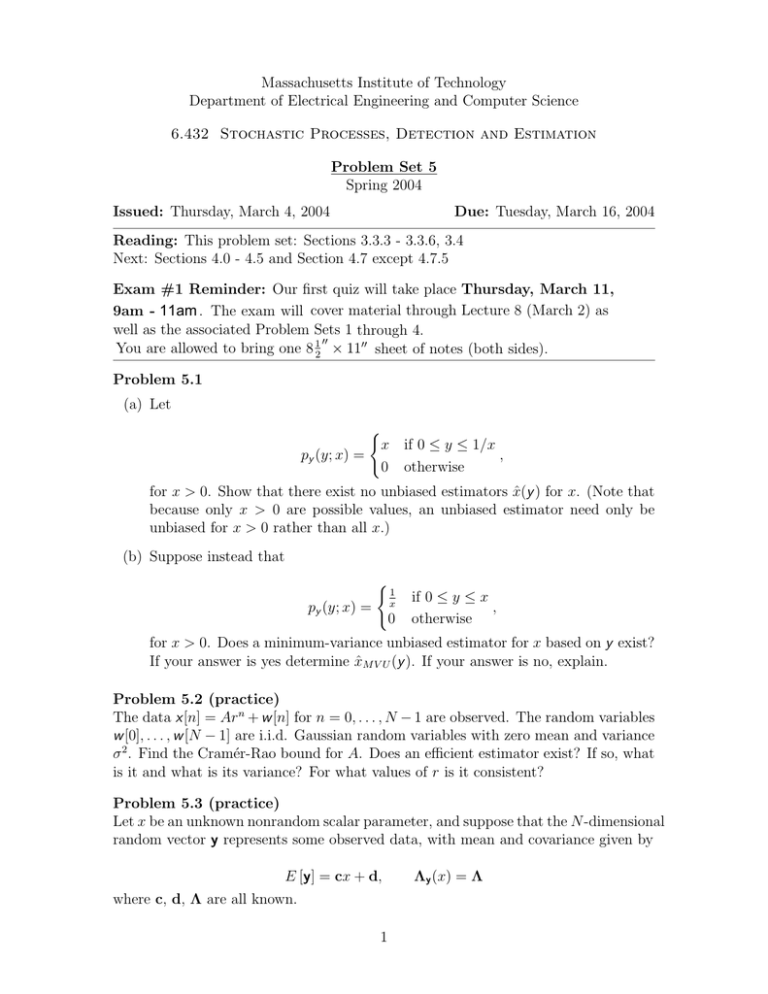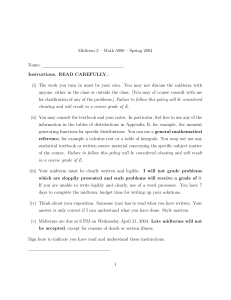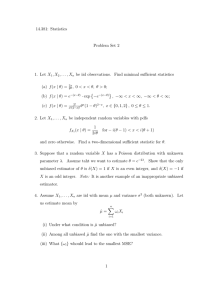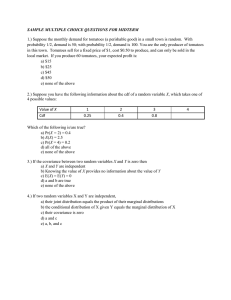Massachusetts Institute of Technology Department of Electrical Engineering and Computer Science
advertisement

Massachusetts Institute of Technology Department of Electrical Engineering and Computer Science 6.432 Stochastic Processes, Detection and Estimation Problem Set 5 Spring 2004 Issued: Thursday, March 4, 2004 Due: Tuesday, March 16, 2004 Reading: This problem set: Sections 3.3.3 - 3.3.6, 3.4 Next: Sections 4.0 - 4.5 and Section 4.7 except 4.7.5 Exam #1 Reminder: Our first quiz will take place Thursday, March 11, 9am - 11am . The exam will cover material through Lecture 8 (March 2) as well as the associated Problem Sets 1 through 4. �� You are allowed to bring one 8 12 × 11�� sheet of notes (both sides). Problem 5.1 (a) Let py (y; x) = � x if 0 � y � 1/x , 0 otherwise for x > 0. Show that there exist no unbiased estimators x(y ˆ ) for x. (Note that because only x > 0 are possible values, an unbiased estimator need only be unbiased for x > 0 rather than all x.) (b) Suppose instead that py (y; x) = � 1 x 0 if 0 � y � x , otherwise for x > 0. Does a minimum-variance unbiased estimator for x based on y exist? If your answer is yes determine x̂M V U (y ). If your answer is no, explain. Problem 5.2 (practice) The data x [n] = Ar n + w [n] for n = 0, . . . , N − 1 are observed. The random variables w [0], . . . , w [N − 1] are i.i.d. Gaussian random variables with zero mean and variance � 2 . Find the Cramér-Rao bound for A. Does an efficient estimator exist? If so, what is it and what is its variance? For what values of r is it consistent? Problem 5.3 (practice) Let x be an unknown nonrandom scalar parameter, and suppose that the N -dimensional random vector y represents some observed data, with mean and covariance given by E [y] = cx + d, where c, d, � are all known. 1 �y (x) = � (a) An estimator xˆ(y) is linear if xˆ(y) = aT y + b for some a, b. Find the unbiased linear estimator xˆ(y) with the minimum variance. (Hint: Lagrange multipliers.) Remark: In the estimation literature, this is frequently (and somewhat ambigu­ ously) called the “best linear unbiased estimator” (BLUE). (b) What is the variance of your estimator in part (a)? Problem 5.4 Suppose, for i=1,2 yi = x + w i where x is an unknown constant, and where w1 and w2 are statistically independent, zero-mean Gaussian random variables with var w1 = 1 var w2 = � 1 x�0 . 2 x<0 (a) Calculate the Cramér-Rao bound for unbiased estimators of x based on obser­ vation of � y1 y= . y2 (b) Show that a minimum variance unbiased estimator xˆMVU (y) does not exist. Hint: Consider the estimators x̂1 = 1 1 y1 + y2 2 2 x̂2 = 2 1 y1 + y2 . 3 3 Problem 5.5 The purpose of this problem is to determine the (unknown) probability of heads when flipping a particular coin. 2 (a) Suppose that the coin is flipped M times in succession, each toss statistically independent of all others, each with (unknown) probability p of heads. Let n be the number of heads that is observed. Find the maximum likelihood (ML) estimate of p based on knowledge of n. (b) Evaluate the bias and the mean-square error of the ML estimate. (c) Is the ML estimate efficient? Is it consistent? Briefly explain. Problem 5.6 (practice) Suppose we observe a random N -dimensional vector y, whose components are inde­ pendent, identically-distributed Gaussian random variables, each with mean x 1 and variance x2 . (a) Suppose x1 is unknown but x2 is known. Does an efficient estimate exist? Find the maximum likelihood estimate of x1 based on observation of y. Evaluate the bias and the mean-square error for this estimate. (b) Suppose x1 is known but x2 is unknown. Does an efficient estimate exist? Find the maximum likelihood estimate of x2 based on observation of y. Evaluate the bias and the mean-square error for this estimate. (c) Suppose both x1 and x2 are unknown. Does an efficient estimate exist? Find x̂ML (y), the maximum likelihood estimate of � x1 x= x2 based on observation of y. Evaluate E [x ˆ ML (y)] and E [(ˆ x1ML (y) − x1 )2 ]. Com­ pare with your results from parts (a) and (b). Evaluate E [(ˆ x2ML (y) − x2 )2 ] assuming N = 2. Compare with your result from part (b). 3









